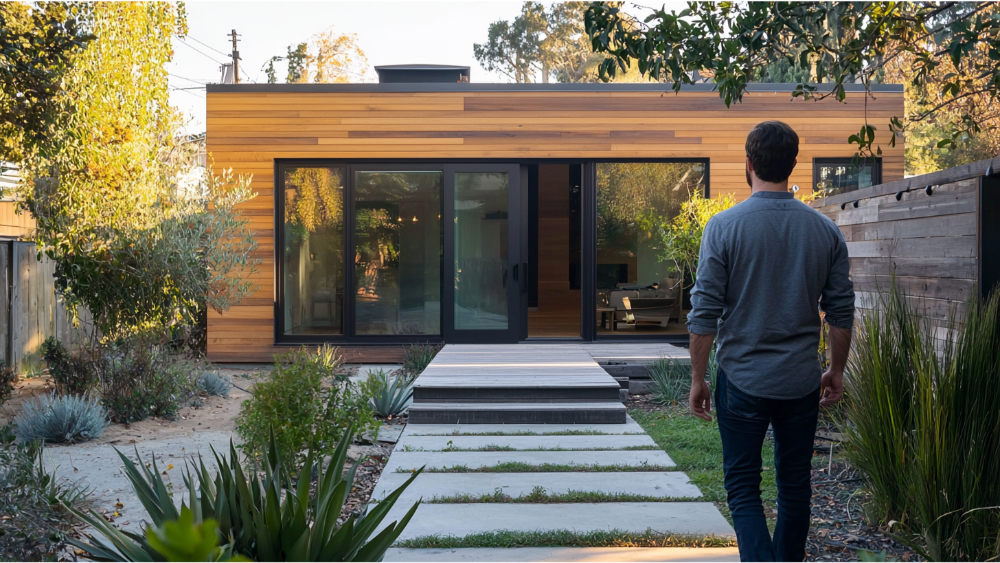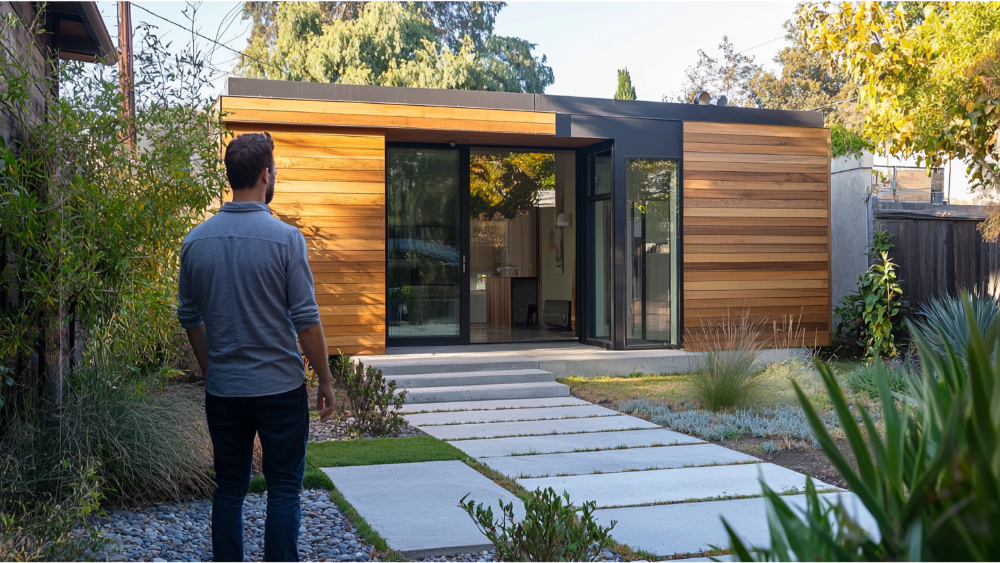In Partnership With
Contact Golden State ADUs
Drop us a line! We look forward to discussing your next project with you!
Cut the chase! Schedule a face-to-face virtual meeting with us today to dive into your project's next steps.
For our returning clients, experience our streamlined, contact-free project proposal process. Simply fill out our short project questionnaire, and we'll deliver your project proposal within 72 hours.
Contact Us:
Follow Us:
How to Get a Grant for an ADU?

- Golden State ADUs
- Comment 0
How to Get a Grant for an ADU?
Building an Accessory Dwelling Unit (ADU) can be a fantastic way to add value to your property and create additional living space. However, the cost of constructing an ADU may be daunting. Fortunately, there are various grants available that can help ease the financial burden. This guide will walk you through the steps to secure a grant for your ADU project.
Types of ADU Grants

Federal Grants
Federal grants for ADUs typically come from programs aimed at encouraging sustainable housing and urban development. These grants can provide substantial funding, but they often come with stringent requirements that need to be met. Ensure you research the eligibility criteria thoroughly to understand what is needed to qualify. Utilizing a federal ADU grant can significantly offset construction costs and enable more affordable housing solutions.
State Grants
Many states offer grants to promote the development of ADUs, often to address housing shortages or encourage eco-friendly building practices. For instance, California offers the CalHFA ADU Grant Program, which provides financial assistance to low and moderate-income homeowners. These state grants tend to have more region-specific guidelines, making it important to understand your state’s specific policies and programs. Utilizing state grants can provide targeted support to bring your ADU project to fruition.
Local Government Grants
Local governments may offer grants for ADUs as part of their community development and housing affordability initiatives. These grants might include incentives for adding affordable housing options or increasing property value within a community. As local government grants can vary significantly, it’s crucial to connect with your local housing authority to learn about available opportunities. These grants often have applications that are easier to navigate compared to federal programs.
Private Grants
Private organizations, nonprofits, or foundations may also provide grants for ADU projects, often focusing on sustainable living or housing affordability. These private grants can sometimes offer more flexibility in terms and can be an excellent resource for innovative ADU designs. Researching potential private grant opportunities can open doors to unique funding channels that might align well with your project goals. They can serve as a vital complement to public funding sources.
Examples of Specific ADU Grant Programs

In recent years, there has been an increasing focus on supporting the development of ADUs to enhance affordable housing and promote sustainable building practices. Here are some notable examples of grant programs available:
California’s ADU Grant Program
One prominent program is California’s ADU Grant Program, which offers financial assistance to help low and moderate-income homeowners build ADUs on their property. Eligible homeowners need to demonstrate their income level and agree to certain affordability requirements.
New York’s ADU Initiative
New York has introduced an ADU grant aimed at assisting homeowners with the construction of energy-efficient ADUs. This program seeks to increase the housing supply while encouraging eco-friendly practices. Grant recipients must commit to implementing sustainable building methods, such as solar energy or efficient water usage.
Oregon’s Affordable ADU Program
In Oregon, the Affordable ADU Program offers grants to support homeowners in developing ADUs that are affordable for low and moderate-income renters. The program emphasizes keeping rental prices within a specified range to ensure accessibility for all community members.
Exploring these “ADU grant” opportunities can lay the groundwork for securing necessary funding and lead to successful ADU project completion. Always verify the latest eligibility criteria and application processes through official program websites or local housing authorities.
Steps to Apply for an ADU Grant

Research and Identify Potential Grants
The first step in applying for an ADU grant is to thoroughly research and identify potential grants that align with your project needs. Look for programs at the federal, state, and local levels, as well as private grants that provide grant money, not a loan. Consider the specific ADU grant funds available in your region, and make note of any unique eligibility criteria or deadlines. Taking the time to identify the best opportunities can save effort and enhance the chances of securing funding.
Check Eligibility Requirements
Some grants have specific criteria, such as income limits, geographic restrictions, or sustainability commitments. Understanding these requirements is essential to ensure that your application aligns with the grant’s objectives. Some ADU grant funds may have competitive selection processes, making it crucial to highlight how your project meets the criteria.
Prepare Documents and Application Materials
After confirming eligibility, the next step is to gather the necessary documents and prepare application materials. This may include financial statements, property deeds, project plans, and other supporting documentation showing how the ADU will be used. Be meticulous in completing application forms and make sure to emphasize how grant money, not a loan, will aid in achieving your project goals. Ensuring accuracy and completeness can strengthen your application’s chances of success.
Submit the Application
With all necessary materials prepared, proceed to submit the application following the specific processes outlined by the granting organization. Pay attention to deadlines and any submission requirements, such as online portals or hardcopy deliveries. A timely and well-prepared application can lessen delays and improve consideration by the grant committee. Confirm receipt of your application to ensure it is under review.
Follow Up and Await Decision
After submission, it is important to follow up with the grant provider to confirm the status of your application if you haven’t received any initial feedback. Some grants involve a competitive selection process, which may require additional interviews or clarifications. Maintaining open communication channels with the grant body can demonstrate your commitment and enhance your relationship with them. Finally, be patient while awaiting the decision, and be prepared to begin the project promptly if awarded the ADU grant funds.
Tips for a Successful Grant Application
Understand the California Housing Finance Agency Requirements
Before applying, thoroughly understand the requirements and constraints of the grant issued by the California Housing Finance Agency, particularly if applying for the California ADU Grant Program. Familiarizing yourself with the nuances of their programs will help in aligning your project goals with their expectations, thus strengthening your application.
Highlight Affordability and Sustainability in Your Proposal
Emphasize how your ADU project will enhance affordable housing solutions and incorporate sustainable practices, key priorities of the California ADU Grant Program. Clearly stating your commitment to affordability and environmental responsibility can make your application more appealing to reviewers evaluating construction or renovation loan options.
Provide Detailed Financial Projections
Ensure that your application includes well-structured financial projections detailing how grant funds, not limited to a construction or renovation loan, will be utilized effectively for the project. This transparency helps demonstrate fiscal responsibility and the project’s feasibility, making your application more compelling.
Leverage Local Support and Partnerships
Mention any local community support or partnerships that could enhance the impact of your ADU project. Collaborations with local agencies or organizations can signal strong community involvement and increase the legitimacy of your application in the eyes of the California Housing Finance Agency.
Revise and Proofread Your Application
Before submission, carefully revise and proofread your application to eliminate any errors or inconsistencies. A well-polished application reflects attention to detail and professionalism, crucial for standing out in competitive grant evaluations like those for the California ADU Grant Program.
Frequently Asked How to Get a Grant for an ADU Questions

Do You Have to Pay Back the California ADU Grant?
The California ADU Grant Program is designed to provide financial assistance to homeowners looking to build accessory dwelling units without the burden of repayment. Unlike loans, grants typically do not require repayment, provided that recipients adhere to the terms and conditions set forth by the grant program. These conditions often include compliance with specific project timelines, usage requirements, and eligibility criteria. It’s crucial for applicants to thoroughly understand these obligations to ensure they maintain grant compliance, thus avoiding any potential financial obligations.
What Type of Loan is Best for an ADU?
When considering financing options for an accessory dwelling unit (ADU), choosing the right type of loan is crucial to align with your financial goals and project requirements. Two common options are construction loans and home equity loans, each offering distinct benefits. A construction loan is specifically designed for new builds or major renovations, providing funds as the project progresses. This type of loan offers structured payments and is typically converted to a standard mortgage upon completion, making it ideal for those focusing on building new ADUs.
On the other hand, a home equity loan allows homeowners to borrow against the equity built up in their existing property. This option might be more advantageous for those who have substantial equity and seek a straightforward, lump-sum loan to fund their project. Ultimately, evaluating your financial circumstances and project plans will help determine the most suitable loan type for your ADU needs.
What is the Income Limit for the CalHFA ADU Grant?
The California Housing Finance Agency (CalHFA) sets specific income limits to determine eligibility for the ADU Grant Program. These limits vary by county and are crucial as they aim to ensure that the grants benefit low to moderate-income households who are most in need of affordable housing solutions.
To qualify for the grant, applicants must fall within the designated income brackets, which are based on area median income (AMI) levels and adjusted for household size. Applicants should consult the CalHFA website or contact the agency directly for the most current income limit guidelines to ensure they meet the requirements before applying.
Conclusion
Securing funding through the California ADU Grant Program can significantly aid homeowners in developing much-needed accessory dwelling units that promote affordability and sustainability. By thoroughly understanding the program’s requirements, emphasizing key priorities such as affordability and eco-friendliness, and maintaining open lines of communication, applicants can enhance their chances of success. Presenting well-detailed financial projections and leveraging community partnerships can further strengthen an application.
Finally, adherence to grant conditions is crucial, ensuring that recipients need not worry about repayment issues. Through careful preparation and a strategic approach, homeowners can make the most of the California ADU Grant, contributing positively to community development and the broader housing landscape.

